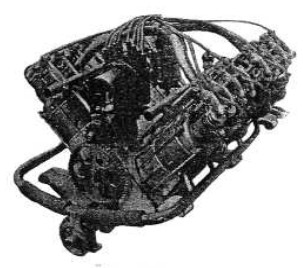Updated: 21-Feb-2019
Also known as "The Hamiltonian".
-The company name comes from Charles K. Hamilton from the state of NY.
-Several engines are known although it is supposed to be modifications of other existing ones.
-In 1909, there was a water-cooled, four-cylinder, in-line engine that gave 60 hp.
-In 1910, there was the Christie giving 110 hp with 8 cylinders in V. It was water cooled as well.
-There is an engine that is recognized as a Curtiss, modified by Ch. Hamilton.

“Hamiltonian”
-The one in the illustration is clearly a Hall Scott engine offered as Hamiltonian. Therefore it has been modified by Charles.
-Two other engines, known as "The Hamiltonian Intercity Flyer", with eight cylinders in V gave 60 HP. It weighed 235 lbs, completely with carburetor, magneto and water pump.
-The "The Hamiltonian Racer", also had 8 cylinders in V and gave 80 hp, weighing 250 Lbs.
From Appendix 6: Curious photograph from the year 1909 in which Charles K. Hamilton appears (seated) showing his engine to Captain Wild. This was the engine for the Eagle airship.
-Precisely the engine has the traces, but it seems somewhat larger than those of the Henderson motorcycle engines.
-It was Hamilton's habit to modify existing engines, (see)

"Photograph of the Eagle engine" (PeT=ps)
Engines of HAMILTONIAN
Model: 4 cyl. in-line, 60 HP
Arquitecture: 4-cylinder In-line
Cooling: Liquid
Total Displacement:
Bore / Stroke:
Power: 60 HP
Weight:
Model: 8 cyl. V, 110 HP
Arquitecture: 8-cylinder V-Engine
Cooling: Liquid
Total Displacement:
Bore / Stroke:
Power: 110 HP
Weight:
Model: 8 cyl. V, 60 HP (Intercity Flyer)
Arquitecture: 8-cylinder V-Engine
Cooling: Liquid
Total Displacement:
Bore / Stroke:
Power: 60 HP
Weight: 235 Lb
Model: 8 cyl. V, 80 HP (Racer)
Arquitecture: 8-cylinder V-Engine
Cooling:
Total Displacement:
Bore / Stroke:
Power: 80 HP
Weight: 250 Lb


